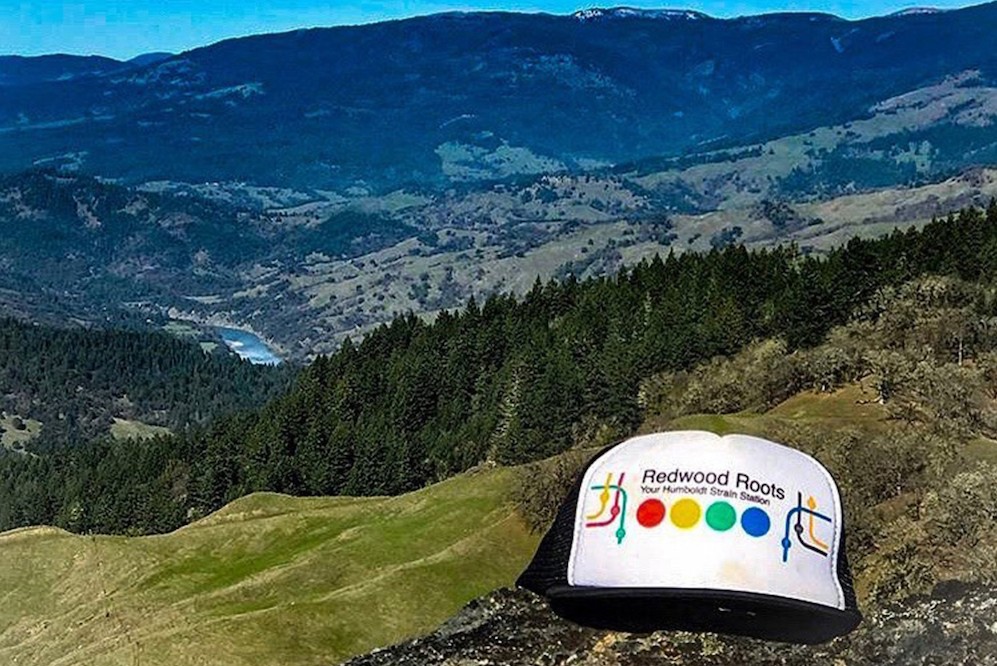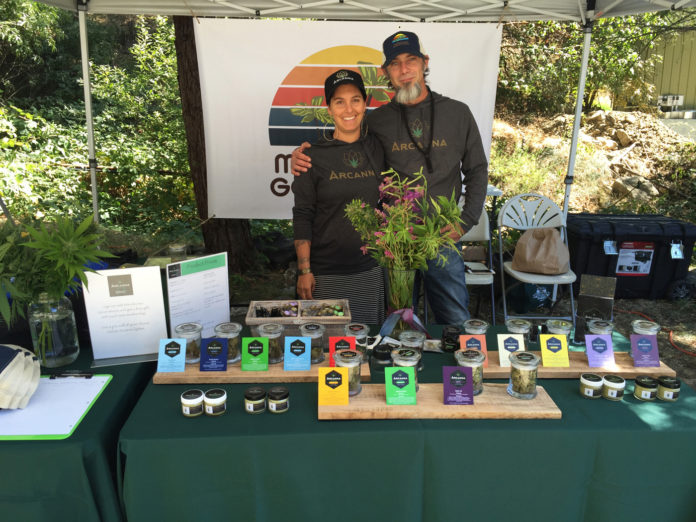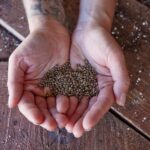If lifelong friendships, family values, fine artisan herb, and smart breeding are enough to fuel a revolution in small farming, Redwood Roots has all the elements it needs to succeed in a “green rush” atmosphere where everybody is betting against them except the people who know them best. Despite what you may have heard about the outlaw culture of California’s Emerald Triangle, and most notoriously the “Murder Mountain” area of southern Humboldt County, this is a tight-knit community of families whose shared experiences over many years have imbued them with a communal toughness they equate with the intertwining “tribal” root system of the redwood forests.
“There are several reasons why we chose the name Redwood Roots and why we thought it was so strong,” said Chris Anderson, who founded the collective in 2015. “‘Redwood trees is where we’re from’ is the obvious one, but the science behind redwood roots—how the forests interact with each other and literally hold each other up by communicating through the root system underneath, through the biology and life force underneath the soil—how they communicate is the Redwood Roots. We are the ancient trees as a community, and the roots of those trees are what is intertwined and helps support the Roots and hold us up. That’s the message behind us.”
Anderson frequently mentions the word “community” when he talks about the process of making Redwood Roots into a legal, functioning entity. The road to legalization has been particularly challenging for small farmers dealing with drastically falling prices and huge compliance costs for ever-changing regulations. Everyone who decided to go legal has been living the challenges, including Anderson.
“In the cannabis industry they call business plans ‘sandcastle’ plans, because you build them around the law and then all of a sudden the law changes,” he said. “You go back and change your plans to conform to the new laws, and guess what? A new wave comes and knocks them over—only this time you build them differently, because you saw the waves coming from another direction.”
It’s just another day at the office when your history includes hiding from helicopters piloted by the U.S. military. “It’s what we’ve done our entire lives up here,” said Anderson. “Adapt, improvise, overcome, support each other, love each other, stick together. It’s in our DNA, second nature. We don’t even think about it. It’s a huge plus.”
Now, that huge plus is being calculated in terms of market penetration, marketing campaigns, licensing opportunities, and expansion strategies that include “retail, transport, distribution, delivery, and the operation of our own manufacturing facility,” according to Anderson. They may still do business on Humboldt Time, but no one at Redwood Roots is fooling around.
The roots of redwood
The story of Redwood Roots is the story of family, plain and simple. “Gregg Gratzel planted the seed in me,” said Anderson. “I really owe a lot to him for instilling in me the idea that this is happening, and maybe it would be a good way to support our people as well as create business for ourselves.” The two men had known one another since childhood. “We were neighbors growing up,” Anderson said. “We’ve known one another that long.”
Long-term relationships are common among the Redwood family of farmers. “Another cultivator was my grandma’s neighbor in Redway,” Anderson said. “We’ve all played sports together, cried together and bled together as children, graduated high school together—not all in the same year, of course. The typical relationships of a small, rural community you find across America. In this one, there just happened to be a way to make money—and lots of it—by staying and not going away to school. Those relationships carried over into adulthood in a very intimate way.”
When Gratzel realized recreational legalization was on the horizon, he reached out to his boyhood buddy. “He had cerebrally started the process of getting his farm under compliance, what it would look like moving forward,” recalled Anderson. “He reached out to me knowing about my property in Benbow and the fact that it would make a fantastic facility and location for cannabis activity. I was in limbo about what to do with it, and he was like, ‘Hey, dude, what do you think about putting a dispensary in there?’ I said, ‘Wow, that’s a great idea.’ I hadn’t really thought about going in that direction.”
Out of such acorns grow mighty oaks, or in this case, redwoods. The Emerald Cup 2015 was only a few weeks away, and the two friends decided to drive down and check out the two-day event. “We ended up walking the show the first day for three or four hours without saying a word, our jaws-dropping, flabbergasted by the magnitude and volume of what was happening,” said Anderson.
“We didn’t stay the first night and talked the whole drive home about what a partnership would look like,” he continued. “Gregg even called his attorney that night, a Saturday, and got us an appointment the next week. We had no idea about the regulations that would come down or what the distribution model would look like. We just thought it was a great idea and decided to open a dispensary. That’s how it started in terms of planting the seed.”
In the end, limitations on allotted licenses forced the two to divide their efforts, with Anderson keeping Redwood Roots and Gratzel forming Humboldt Mountain, which today is called G Verde and is a member of the Redwood Roots family of farms. The collective model was a feature from the get-go. “We went with a collective model from the beginning so we could utilize the patient base,” said Anderson. “The thought was, ‘Let’s use the laws to protect our people while we work together to cut costs.’ That transitioned quickly into pushing distribution services.
2015 was a year of beta-testing at events. “We got really good feedback,” said Anderson. “The brand and mark were strong, and our story was one of a kind. It was obvious we were doing the right thing and heading down the right road. At that time, our intention was to bring on maybe twenty-five farms, because we knew we weren’t going to be able to service more than that. Our theme then and now is that we will not over-promise and under-perform.”
As expected, the collective grew organically. “We didn’t make the launch of Redwood Roots public or do any radio spots,” said Anderson. “It was basically word of mouth, talking among friends about what Redwood Roots could do for them in terms of protection and the law, coming out of the shadows into the light. ‘Here we are in the light,’ we told them. ‘Come and join us. We’d like you to come.’ It was slow, organic growth among people intrigued not just about Redwood Roots, but the process of going legal and what that would look like working as a group. The idea was, ‘If these guys are doing it, we can do it, too.’ The conversation literally spread from neighbor to neighbor: ‘Maybe you should go have a conversation with Chris.’”
Redwood Roots encompassed forty-four farms at one point, with most of the workload split between Anderson and Holly Carter, his righthand person at the time. “We were doing all the work, and it just got to be too much,” he said. “The quality of service went down. I had a cultivation site and a nursery, and I was spread too thin.” By the end of 2016, Redwood Roots had downsized to a couple dozen farms.

Valentine’s Day
February 14, 2019, marked a very special occasion for the Redwood Roots team, which, in addition to the farmers and farms that make up the collective, is composed of new and longstanding helpers working to create a vision of small-farm self-determination and independence that everyone on the team passionately shares. The first order of business for Anderson was to celebrate survival. “First, [we wanted] to take some time to celebrate the fact that we’ve persevered through tough times of prices falling out from underneath us, spending all our money on lawyers and consultants from engineering companies and whatnot, and we now have licenses from the state of California to sell cannabis to the people. And that is a big reason to celebrate,” said Anderson. “We have persevered as small farmers, and as people we have persevered together, and we now can follow through on this whole idea of being a distributor for all of these wonderful families that started all of this. The celebration is simple in that we made it this far and we’re still here, and now we get to go do what we do.”
February 14 also marked the official start of RR distribution, as well as other limited services. “The Benbow dispensary should open by August 1, with a third of the storefront dedicated to retail,” said Anderson. “It’s a warm, cozy space that will have a museum-esque atmosphere, with art on the walls and reading material on the coffee tables that focuses on the history of southern Humboldt and the cannabis culture that started it all.”
The prime location is immediately off Highway 101, within eyesight of the renovated Benbow Hotel and adjacent to its nine-hole golf course, which also needs renovating. Until August 1, said Anderson, Redwood Roots will utilize its delivery license to set up service that will extend from Trinidad to the North Bay.
The collective consistently has offered limited-release products, but its reconfiguration as a fully licensed, multifaceted entity represents a new order of magnitude for the brand. “We’ll be rolling out with twelve to fifteen farms offering thirty-six flavors, or strains,” said Anderson. “We’ll start with flower and pre-rolls, followed soon by other product lines. Within probably the first three or four months we are operational, Redwood Roots will also have a full product line that is branded and cobranded with farmers and other manufacturers on a range of product lines that will include salves, vape pens, tinctures, lip balms, and edibles. Expect a full line of products coming from Redwood Roots in the spring and summer of 2019.”
In terms of financing its operations, Redwood Roots, in typical fashion, wants to include locals. “We are giving an opportunity to the local community and farmers so they can own a piece of this company and help grow it from the foundation up,” said Anderson. “We want to keep as much value in the community as possible.
“It’s always been an extraction community,” he continued. “In the past, money from that extraction went to companies that were not from here and didn’t give a damn about the people from here. Our intention is to keep as much money in the Emerald Triangle as humanly possible.
“We anticipate there will be a need for a large injection of capital that will not come from this community,” he added, “but when it happens it will be a very strategically chosen investor or group of investors. Ideally, they will come from the industry and are strategic partnerships that bring more than money to the table.”
Like everyone in Northern California, he’s danced the dance. “We’ve been approached by investors and entered into negotiations that were supposed to lead to win-win situations, but in the end, they weren’t win-win and weren’t right for the vision for the company,” he said. “We know we’re going to have to pivot, but those investor relationships fell through because they weren’t the right people.”
Good breeding
“Community spirit is still our way forward, working together to cut our costs,” said Anderson. “We’re talking about starting a [group purchasing organization]. It would not be a Redwood Roots entity, but a farmer-owned, for-profit company that would have skilled negotiators go out and negotiate with vendors to get steeply discounted prices for everything. Not just cost-of-goods things like dirt and fertilizer, but also health insurance, workers comp[ensation] insurance, vehicles, gas, groceries, travel. Anything that can be group-purchased, we go out and negotiate discounts.”
The discounts would not be for farmers only. “The GPO would lift all boats in the community, because it is not limited to farms,” said Anderson. “Anyone in the community can join and cut costs, even if it’s for one vehicle a year. If you save 30 percent, you’ve just saved a whole lot of money. It’s an across-the-board entity that can drive the cost of living down.”
For Anderson, the GPO is one of the ways his community can overcome challenges facing the artisan farmer. “These are fluffy things that can help us overcome challenges as we move forward, but I truly believe in staying true to our values, being authentic, being who we truly are as a community. They’re not just words produced by a marketing firm. What’s going to sell is our story and the people, the human beings behind the herb that’s being cultivated. It’s being cultivated by family hands getting dirty in the earth, getting up at 5:30 a.m. and not going to bed until 10 p.m., because they’re out literally with their children on their backs farming this ganja for you.
“Maybe I’m a dreamer,” he added, “but I truly feel that what we are and who we are is so marketable right now. Health and wellness are very hot across the country and the world right now—yoga, Pilates, whole-foods shopping, farm-to-table restaurants are everywhere in Southern California. Millennials want to know where their products come from, and that the companies they support are community-oriented; that they’re giving back. We don’t even have to try to do that, because that’s just who we are. I feel like having those things inside of us puts us a step ahead from what the big companies are trying to market themselves as. We support the small farmers of Northern California, and we only use organic fertilizer.”
Genetics also will play a key role in the success of Redwood Roots going forward. “The original seed smugglers came to Humboldt [County],” said Anderson. “This is where all the genetics came into this country, and about half the farms we’re working with now have genetics projects going on. These are people who have been working on genetics for years, some for decades. They have some consistent, strong seed stock that they’ve developed over time and continue to develop. I absolutely think genetics are one of the important factors moving forward for Redwood Roots—or anybody, really.”
With many farms to work with, Redwood Roots has enviable options, genetically speaking. “We’ll have five to seven strains we always carry that will be the standard strains we know will sell, that everybody likes,” he said. “But then there will be more than a hundred varietals we can choose from, including designer strains from Los Angeles that get up here that we can tweak and make our own. Most of those strains originally came from somewhere up here anyway.”
Regarding the question of when to release new strains, Anderson said timing is everything. “There’s no reason to hoard genetics anymore, because it’s not going to do you any good in the market,” he cautioned. “You’ve got to create a demand for it, and to do that there has to be a certain amount of it or you have to win an award. Genetics and the issue of when to release and what farmers are doing about it is super fascinating to me.”
Taking the show on the road
Anderson’s parents and grandparents operated restaurants and gift shops in the area. He was raised in the service industry, not on a farm, giving him a unique perspective about the industry. “I understand the tourism economy from a different perspective than some other folks in the area,” he said. “I have seen redwood tourism fall off over the past few years, and I haven’t seen a big push from the chamber of commerce or the bed-tax people [to fix it]. It’s time to resurrect redwood tourism as a combination of canna, redwood, outdoors, fishing, hiking, surfing. We need to market it as a destination location for experiences that are beyond cannabis and beyond the redwoods.
“Tourism is a monster part of this community surviving and moving forward, because it’s so much more than selling a product to the consumer down the road,” he added. “That doesn’t do any good for the businesses in town, and this is a community. We’re all in this together. It’s a package deal.”
Anderson doesn’t intend to build it and wait for them to come, however. He wants to hand-deliver his community to the world. “We’re going to take the Redwood Roots-[Southern Humboldt] circus on the road, and we want to bring everybody with us,” he said. “The musicians of Humboldt are coming to do the music; the chefs are coming to make the food. We’re bringing everything else—the food, the massage therapists, the yoga practitioners, the speakers about regenerative farming practices, the farmers and their products, and we’re taking it all on the road. It’s a huge part of expressing who we are and getting that face time with the consumer.”
Redwood Roots’ Family of Farms
Clearwater Farms
Cut Creek
Formidable Flower
G Verde
Galen Farm
Hidden Prairie
High Tree
Humboldt Cure
Humboldt Generations
Humboldt Infuzions
Humboldt Redwood Healing
King Range
Lady Sativa
Mattole Valley Sungrown
Riverview Gardens
Savage Farms
Sohum Royal
Twin Creeks
Uplift Coop
Westside Heritage













